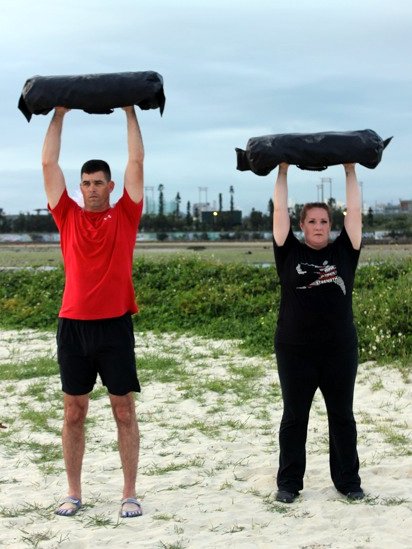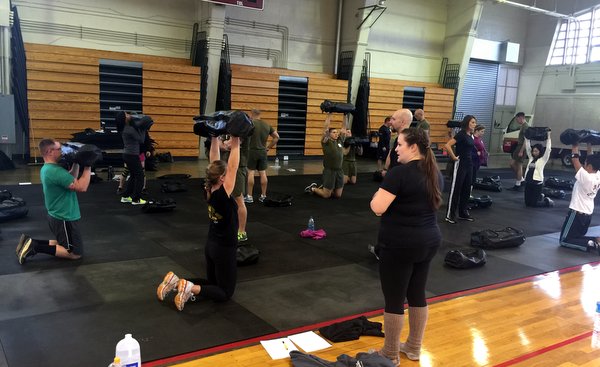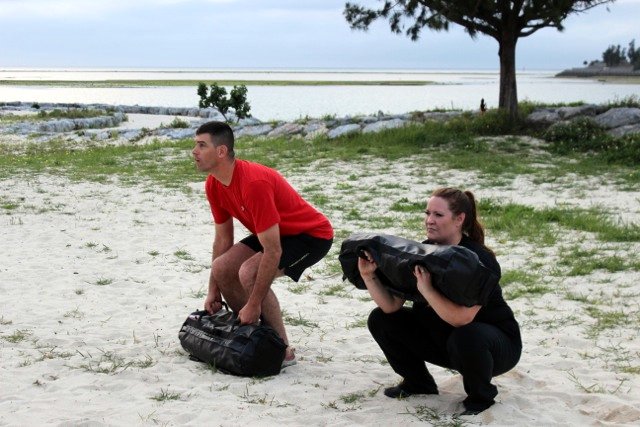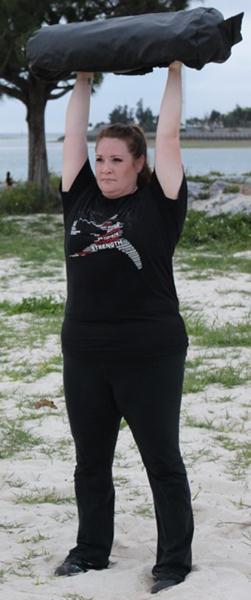An Interview with Faith Martin, HKC, DVRT, Fitness Director of Health Promotion, US Marines
By Adrienne Harvey, SrPCC, RKC-II, CK-FMS

Dragon Door: How would you describe your job?
Faith Martin: I am currently the Fitness Director of Health Promotion, a part of SemperFit with MCCS. I am in charge of the fitness coordinators who do the assessments daily for Marines, and am also the HITT coordinator for the island. I teach a multi-modality course with a lot of different strength tools like ammo cans,
kettlebells, and DVRT/Ultimate Sandbag. I teach many of these classes and also am a yoga teacher trainer.
Dragon Door: How did you get started with this career?
Faith Martin: At first I was just a contractor and had a business in Arizona teaching yoga. But since my husband has been in the Marine Corps for a long time, I wanted to find a position where I could give back. After I started working with the Marines, I continued to learn more, and go for more certifications. I was also very interested in teaching the High Intensity Tactical Training (HITT) to the military.
Dragon Door: What attracted you to the HKC and DVRT?
Faith Martin: I got a little taste of the DVRT at the HITT Level 2 training course in Miramar last September and I really enjoyed it. I liked how the Ultimate Sandbag is not a fixed component, the weight shifts—it’s not a fixed modality. I also appreciated how the technique translated to advanced barbell moves—like a clean for example. It someone is uncomfortable training some of the barbell moves, they can work with the
Ultimate Sandbag first, or instead. The training seemed useful for the Marines here.

With the
HKC—and eventually I'd like to get my RKC—I am able to give back more training information to the Marine Corps. Before, many of the modalities like kettlebells were only used a certain way because someone had figured it out that way or from habit, now I’d like to give them better education. That's what attracted me to the DVRT, HKC, and RKC systems.
Dragon Door: How are you able to help with some of the biggest fitness challenges facing the Marines?
Faith Martin: I think that using different systems like the DVRT and HKC can replace the missing elements in their fitness training. This is also why the HITT the (high intensity tactical training) was invented. With HITT, they work on speed, agility, movement preparation, endurance, as well as strength, power, flexibility and mobility. Because it teaches rotation, the DVRT is an especially great way to implement the HITT program. Marines tend to just train in the sagittal plane, and the DVRT can expand their movement patterns. I like the way that the DVRT is comprehensive, and can be adapted to make sure all of the movement patterns and planes are trained.
Dragon Door: How did you originally become interested in fitness?
Faith Martin: When my husband left for Iraq, I was here in Okinawa, 100lb heavier, and not really into fitness. I started with yoga, then began to learn more about Pilates, the body, and eventually went on to earn certifications in TRX, HITT Level 1 and 2, DVRT, and HKC
kettlebell training. I am now certified as a Tactical Strength and Conditioning Facilitator and have continued to grow from there. I am also certified in advanced Olympic weightlifting.
Dragon Door: What was your athletic background?
Faith Martin: I didn’t have one—not even one bit! But, I just really enjoyed the challenge; I want to offer that same kind of challenge and education to the Marines. It was doubly important for me—personal growth and growth I could share with the Marine Corps.
Dragon Door: How long have you been a Tactical Strength and Conditioning Facilitator?
Faith Martin: I became certified about a year ago. When my husband left for Iraq in 2005, I started doing yoga and became a yoga teacher trainer, but I started all the hard-core stuff about a year and a half ago.

Dragon Door: That’s a great example of making big changes, then going on to help and teach others! What’s your favorite kettlebell move?
Faith Martin: I really like the windmill, but from the HKC training, I really enjoyed the get-up most of all. When training the get-up at the HKC, they expected us to use awareness of our bodies, to move slower, and to really notice the movements we were making. This approach really made the get-up challenging, and I’m proud that when I finished the
HKC workshop, the instructors said I did the best get-up they’d seen! I felt good about that and continue to try making it better. I also like how the get-up can be broken up into smaller movements.
 Dragon Door:
Dragon Door: Which drills from the DVRT do you think are the most challenging?
Faith Martin: I like the Ultimate Sandbag clean-to-fist with the press overhead. At the
DVRT, we practiced a timed drill with the clean-to-fist and press, and I liked the power I felt with it. Most people don't realize how difficult the clean-to-fist, then overhead press really is—but that drill makes me feel very powerful and capable. When we first watched the instructor demonstrate it, it seemed simple until we tried it ourselves. It seemed like the bag was causing the difficulty!
Dragon Door: How are you specifically using the HKC kettlebell and DVRT information with the Marines?
Faith Martin: In the High Intensity Tactical Training (HITT) level 1 and 2 courses—a five day program for level one, and a four day for level two—we give them our knowledge of how the
DVRT and HKC modalities can be used in their fitness programs. Basically, we're teaching the Marine Corps fitness instructors how to better provide activity and unit physical training for their environments. I recently delivered my first almost standalone course at Camp Fuji on mainland Japan. It was DVRT training which coincided with what Josh Henkin is teaching at Marine Corps headquarters. With the knowledge Josh and his excellent instructors passed on to me, I felt completely confident in teaching a 1.5 hour sample training on how the DVRT and HKC kettlebell training can be implemented with their training.
Dragon Door: Earlier, you mentioned wanting to do the RKC workshop, what other goals are you currently working towards?
Faith Martin: I would like to do the DVRT Level 2 and the RKC because that information would let me give even more knowledge back to the Marine Corps community. Because kettlebells and Ultimate Sandbags are very important in the HITT program, I want to make sure that I'm really giving the Marine Corps all that they need. I hope to encourage them to seek out the DVRT, HKC and
RKC courses for themselves as well.
Dragon Door: What’s your unique approach as an instructor?
Faith Martin: I might be a little bit different because I like to incorporate a mind-body focus into everything that I teach. I want to really help people understand why they are training or moving a specific way with the sandbags, and kettlebells. I want to teach them the safest ways and how to get the most out of their training programs. Most of the time flexibility and mobility training is left out of their programs, but by using different equipment modalities like kettlebells and sandbags, we can more easily include flexibility and mobility in their programs.
Dragon Door: Are there any particular moves from the HKC and DVRT that strike you as being particularly profound for mind-body connection and focus?
Faith Martin: When I was first introduced to the kettlebell swing, someone just told me to pick up a kettlebell and start swinging it between my legs. That method didn't always feel comfortable, and I didn't understand what I was doing. After researching more about why I was swinging the kettlebell, I learned more about its history. After the HKC training, I noticed that the Marines tend to squat with their swings—and now I knew how to teach them to hip hinge instead.
When I did the HKC,
Steve Holiner caught me on my hip hinge. At the time I thought I already had it down, then realized I could be hinging much more to get a lot more power and explosiveness from my hips. I’ve realized how difficult it can be to teach someone else—who may not have as much awareness of their body—to learn and understand the hip hinge. Teaching the hip hinge and that awareness is a great challenge for me. It's a work in progress. Steve knew all the right cues to help me hinge a little bit more and become confident with the explosiveness of the movement.
Back